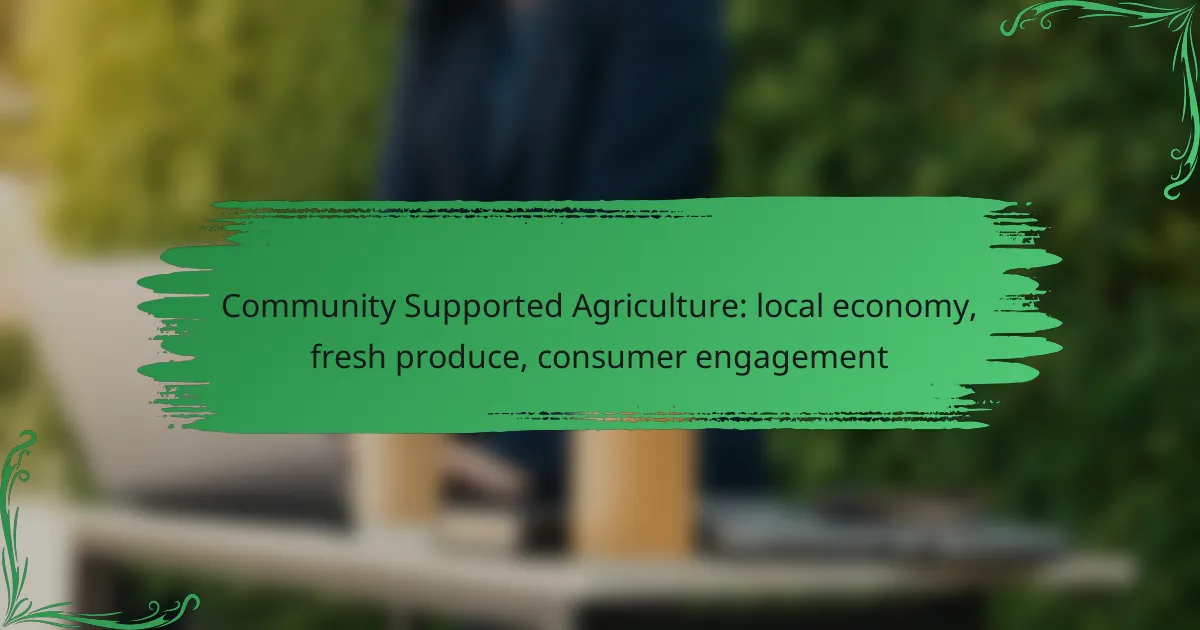Community Supported Agriculture (CSA) plays a vital role in strengthening local economies by creating direct connections between consumers and farmers, which boosts local spending and job creation. By providing access to fresh, seasonal produce, CSA not only promotes healthier eating habits but also encourages community engagement through various activities, ultimately fostering a more sustainable agricultural system.

How does Community Supported Agriculture benefit local economies?
Community Supported Agriculture (CSA) enhances local economies by fostering direct relationships between consumers and farmers, leading to increased local spending and job creation. This model allows communities to invest in their agricultural systems, resulting in a more resilient and sustainable local economy.
Increased local spending
CSAs encourage consumers to purchase shares of produce directly from local farms, which keeps money circulating within the community. This spending supports not only the farmers but also local suppliers and service providers, creating a multiplier effect that benefits various sectors.
For instance, when a family buys a CSA share, they are likely to spend additional money at local markets, restaurants, and stores, further boosting the local economy. This can lead to a significant increase in local economic activity, often estimated to be several times the initial investment in the CSA.
Job creation in agriculture
By increasing demand for locally grown produce, CSAs contribute to job creation within the agricultural sector. As farms expand to meet the needs of their CSA members, they often hire additional workers for planting, harvesting, and distribution.
Moreover, these jobs can vary from seasonal positions to more permanent roles, providing a range of employment opportunities for local residents. This not only helps reduce unemployment but also fosters a skilled workforce in the agricultural sector.
Support for local farmers
CSAs provide farmers with upfront financial support through membership fees, which helps them cover production costs before the harvest. This financial stability allows farmers to invest in better practices and equipment, leading to improved quality and quantity of produce.
Additionally, CSAs create a loyal customer base that values local food, encouraging farmers to maintain sustainable practices. This support can be crucial, especially for small-scale farmers who may struggle to compete with larger agricultural operations.
Boost to local businesses
The success of CSAs can lead to increased demand for local businesses that supply agricultural inputs, such as seeds, fertilizers, and tools. As farmers thrive, they often seek out local vendors, creating a symbiotic relationship that strengthens the local economy.
Furthermore, CSAs can collaborate with local restaurants and markets to feature their produce, enhancing visibility and sales for both parties. This partnership can create a vibrant local food scene, attracting more customers and fostering community engagement.

What are the advantages of fresh produce in Community Supported Agriculture?
Fresh produce in Community Supported Agriculture (CSA) offers numerous benefits, including enhanced nutritional quality, access to seasonal crops, and a smaller environmental impact. These advantages contribute to healthier eating habits and support local economies.
Higher nutritional value
Fresh produce from CSA programs typically has a higher nutritional value compared to items found in conventional grocery stores. This is largely due to the shorter time between harvest and consumption, which helps preserve vitamins and minerals. Consumers often report that locally sourced fruits and vegetables taste better and provide more health benefits.
To maximize nutritional intake, consider participating in a CSA that emphasizes organic farming practices. Organic produce is often grown without synthetic pesticides and fertilizers, further enhancing its health benefits.
Seasonal variety of crops
CSAs provide a diverse selection of seasonal crops, allowing consumers to enjoy a wide range of flavors and nutrients throughout the year. This seasonal variety encourages individuals to explore new recipes and ingredients, which can lead to a more balanced diet.
For example, a summer CSA might offer tomatoes, cucumbers, and peppers, while a winter share could include root vegetables like carrots and turnips. Engaging with seasonal produce can help you appreciate the natural growing cycles and make more informed choices about your food.
Reduced carbon footprint
Participating in a CSA can significantly reduce your carbon footprint by minimizing the distance food travels from farm to table. Local sourcing cuts down on transportation emissions and supports sustainable farming practices that are often more environmentally friendly.
To further decrease your environmental impact, consider choosing a CSA that practices regenerative agriculture. These methods improve soil health and biodiversity, contributing to a healthier ecosystem overall.

How can consumers engage with Community Supported Agriculture?
Consumers can engage with Community Supported Agriculture (CSA) by joining programs, participating in events, and volunteering on local farms. These activities foster a direct connection between consumers and farmers, enhancing the local economy and promoting fresh produce.
Joining a CSA program
Joining a CSA program typically involves purchasing a share of a farm’s harvest in advance. This arrangement allows consumers to receive regular deliveries of fresh produce, often weekly, during the growing season. Shares can vary in size and price, generally ranging from $200 to $800 per season, depending on the farm and the quantity of produce offered.
When selecting a CSA, consider factors such as the types of produce offered, the farm’s growing practices, and the pickup or delivery options available. Many farms provide flexibility in share sizes and payment plans, making it accessible for various budgets.
Participating in farm events
Farm events, such as open houses, harvest festivals, and workshops, provide opportunities for consumers to engage with local agriculture. These events often include farm tours, cooking demonstrations, and educational sessions on sustainable farming practices. Participating in these activities helps build community ties and deepen understanding of food production.
To find farm events, check local CSA websites, community boards, or social media pages. Many farms encourage families and individuals to attend, making it a fun way to learn while supporting local agriculture.
Volunteering on local farms
Volunteering on local farms allows consumers to gain hands-on experience while supporting the agricultural community. Many farms welcome volunteers for tasks such as planting, weeding, and harvesting, often in exchange for fresh produce or farm credits. This arrangement can be a rewarding way to learn about farming and contribute to local food systems.
Before volunteering, research local farms to understand their needs and schedules. Some farms may require a commitment of a few hours a week, while others might offer one-time volunteer days. Always communicate clearly about expectations and availability to ensure a positive experience for both you and the farm.

What are the prerequisites for starting a Community Supported Agriculture program?
To start a Community Supported Agriculture (CSA) program, you need a clear understanding of local demand, a network of local farmers, and a solid business plan. These elements ensure that your CSA meets community needs while supporting local agriculture.
Understanding local demand
Assessing local demand is crucial for a successful CSA. Start by conducting surveys or hosting community meetings to gauge interest in fresh produce and specific crops. This will help you identify what potential members are looking for and how much they are willing to pay.
Consider the demographics of your area. For instance, urban areas may have a higher demand for diverse produce, while rural communities might prefer staple crops. Engaging with local residents can provide insights into seasonal preferences and dietary trends.
Building a network of local farmers
Creating a robust network of local farmers is essential for sourcing quality produce. Reach out to nearby farms and establish partnerships that align with your CSA’s goals. This collaboration can enhance product variety and ensure that you have a reliable supply chain.
Attend local agricultural events or farmers’ markets to connect with potential partners. Building relationships with farmers can also facilitate shared resources, such as equipment or distribution methods, which can lower operational costs.

How do Community Supported Agriculture models vary by region?
Community Supported Agriculture (CSA) models differ significantly across regions due to local agricultural practices, consumer preferences, and economic conditions. These variations influence how consumers engage with farmers and the types of produce available in their communities.
Urban vs. rural CSA structures
Urban CSAs often focus on smaller-scale operations that cater to city dwellers, utilizing limited space for intensive farming methods such as vertical gardening or rooftop farms. These models may offer weekly delivery services or pick-up points in convenient locations, making fresh produce accessible to busy consumers.
In contrast, rural CSAs typically involve larger farms that can provide a wider variety of crops. Members often visit the farm to pick up their shares, which can include seasonal fruits, vegetables, and sometimes even meat or dairy products. This direct interaction fosters a stronger connection between consumers and farmers.
Regional crop availability
The types of crops available through CSAs largely depend on the local climate and soil conditions. For instance, regions with warmer climates may offer a bounty of tomatoes, peppers, and melons, while cooler areas might focus on root vegetables and leafy greens. Understanding local agricultural strengths can help consumers choose a CSA that aligns with their preferences.
Additionally, seasonal variations play a crucial role in crop availability. Many CSAs operate on a subscription basis, providing members with a share of what is harvested each week. This means that consumers may receive different items throughout the growing season, encouraging them to explore new recipes and cooking methods.

What are some successful examples of Community Supported Agriculture?
Successful examples of Community Supported Agriculture (CSA) demonstrate how local communities can engage with farmers to access fresh produce while supporting the local economy. These initiatives often involve consumers purchasing shares of a farm’s harvest in advance, fostering a direct relationship between producers and consumers.
Brooklyn Grange in New York
Brooklyn Grange operates rooftop farms across New York City, providing fresh, organic produce to local residents and restaurants. By utilizing underused urban spaces, they create a sustainable food source while engaging the community through workshops and events.
Members can subscribe to a CSA program, receiving a weekly share of seasonal vegetables, herbs, and flowers. This model not only supports local agriculture but also promotes awareness of sustainable practices among city dwellers.
Farm Fresh Rhode Island
Farm Fresh Rhode Island connects consumers with local farmers through various programs, including a robust CSA network. They emphasize seasonal eating and provide educational resources to help consumers understand the benefits of supporting local agriculture.
The organization offers a variety of subscription options, catering to different family sizes and dietary preferences. Additionally, they facilitate farmers’ markets and community events, enhancing consumer engagement and fostering a strong local food culture.



